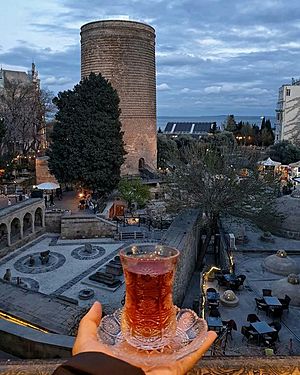Azerbaijani tea culture facts for kids

In Azerbaijan, tea is more than just a drink; it's a big part of their culture and hospitality! When you visit an Azerbaijani home, you'll almost always be offered a freshly brewed, hot, and strong cup of tea. It usually has a bright color and is served in special glasses or cups. Many Azerbaijanis use a traditional armudu glass, which is shaped like a pear. This shape helps keep the tea hot at the bottom while cooling it slightly at the top, making it perfect for sipping.
Tea is served all the time when guests are around or when people are having a good chat. Unlike in some other countries, Azerbaijanis don't usually drink tea with milk. They often enjoy their tea with lemon, cube sugar, sweets, and fruit desserts (but not jam). Sometimes, they add herbs like thyme, mint, or even rose water. People believe these additions are good for your stomach and heart.
There's a cool old story about why people might use lump sugar instead of loose sugar. Back in medieval times, rulers who were worried about being poisoned would dip a piece of sugar into their tea. They believed that if there was poison, it would react with the sugar.
For Azerbaijanis, tea means warmth and being welcoming. An old tradition says that you should never let a guest leave your home without offering them at least one cup of tea.
Tea also plays a special role in matchmaking traditions. When families are discussing a possible marriage, after the matchmakers have talked, a maid will bring out tea. If the tea is served without sugar, it's a sign that the marriage might not happen. But if the tea comes with sugar, it means a wedding is likely!
Chaykhana: Traditional Tea Houses

Many Azerbaijani people enjoy their tea in traditional tea houses called chaykhana. These places are often where men gather to relax. They might play games like backgammon (which they call nard), read newspapers, and, of course, drink lots of tea. Historically, chaykhanas were mainly places for men to socialize.
Tea's Journey in Azerbaijan
Tea production used to be a very important industry in Azerbaijan. The first tea bushes were planted for business as early as 1912. However, tea growing really took off in the 1930s when Azerbaijan was part of the Soviet Union.
In 1934, experts from Moscow visited a region called Lankaran. They took soil samples and found that Lankaran was one of the best places to grow tea! Because of this, tea factories started operating in Lankaran and nearby areas. Since then, Lankaran has become a major region in Azerbaijan for growing not just tea, but also rice, citrus fruits, and vegetables.
Tea production reached its highest point in the 1980s. During that time, about 34,000 to 38,000 tonnes of tea leaves were harvested every year! But after the Soviet Union broke apart, tea production decreased a lot. In 2007–2008, it was at its lowest, with less than 500 tonnes harvested.
Samovar Tea: Boiling Water the Old Way
In Azerbaijan, people often boil water for tea in special heated metal containers called samovars. These aren't just for boiling water; they're also a symbol of tea culture.
Interestingly, an archaeologist named Tufan Akhundov found a pottery samovar in Sheki, a town near the Caucasus mountains. This ancient samovar might be as old as 3,600 years! This shows that the tradition of using samovars for tea has a very long history in Azerbaijan.

